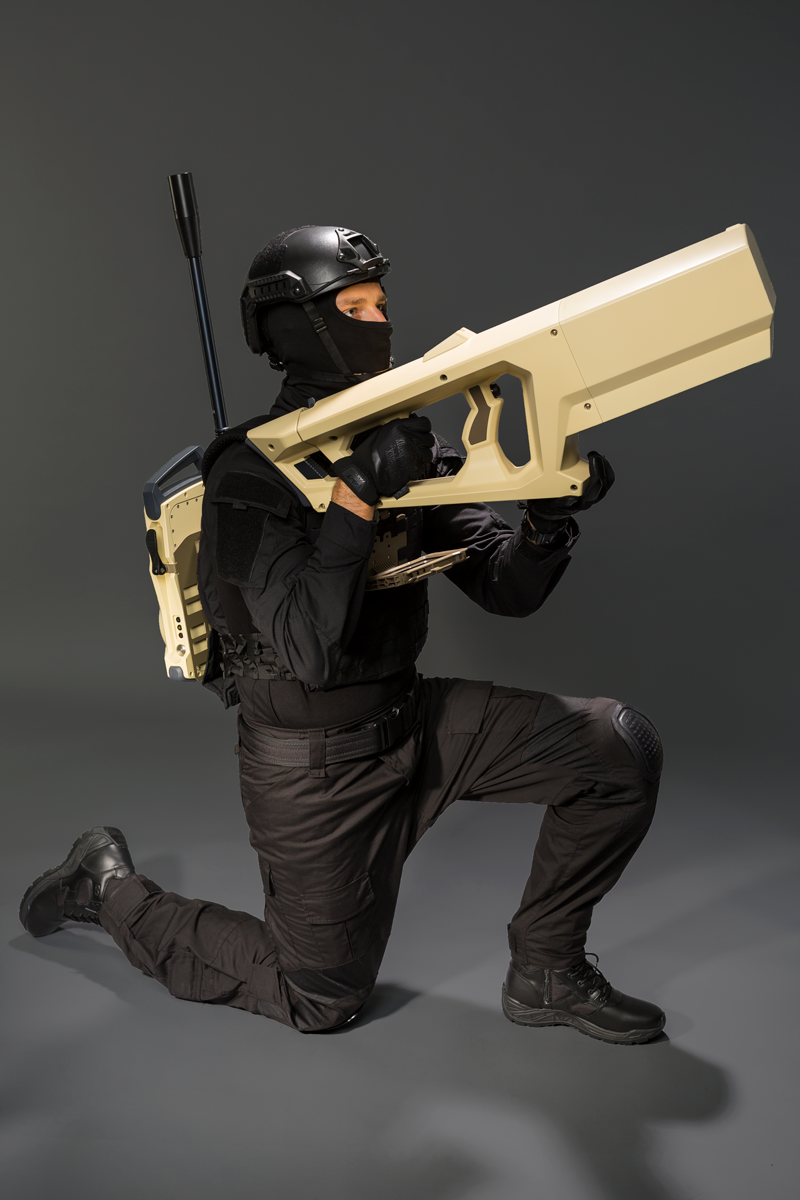MONTROUGE, France, Sept. 29, 2020 /PRNewswire-PRWeb/ -- Genesis of the CHIMERA project
Against the threat caused by malevolent drones, very little resistance is being opposed. There is a strong asymmetry between drones and conventional anti-air defense systems.
- Civilian UAV are easy to use, often inexpensive, and can be flown in narrow urban areas.
- AA (Anti-air) systems are only accessible to military entities and often require numerous highly qualified personnel.
These multi-million dollars investments rely on kinetic means of neutralization, making them unsuited for rural environments. They are inadequate for this fight. Therefore, an anti-drone defense system should replicate the factors which make civilian UAV plausible threats: mobility, portability, ease of use and cost-efficiency.
Project development
The CHIMERA solution is composed with 3 connected hardware items: an antenna, located in the dedicated backpack, a digital C2 (Command and Control) tablet attached to the front of the tactical vest, and an effector.
By the omnidirectional analysis of the surrounding radiofrequency spectrum CHIMERA processes the DETECTION stage. This method allows to visualize the packets of information within the wireless communication link, shared between the drone and its operator. Compared to our empirically developed database, they are key indicators which allow to identify unique UAV RF signatures.
Unlike the HYDRA solution, the mono-sensor configuration doesn't allow for a TDOA (Time Difference Of Arrival) localization. As soon as the alarm goes out, displayed on the digital tablet, the LOCALIZATION of the drone and its pilot are done manually, using the directional antenna.
Once the rogue drone is confirmed, NEUTRALIZATION can be operated by emitting an electromagnetic impulse. At BVLOS (Beyond Visual Line of Sight) distances, the operator keeps the threat outside of his tactical safety area.
Thus, CHIMERA's architecture allows the operator to limit the threat neutralization process to 3 steps, using a portable and mobile system:
- The omnidirectional detection of the drone
- The localization of the UAV and his operator using manual goniometry
- The BVLOS neutralization
CHIMERA differentiate itself from conventional anti-drone rifles, from which the absence of sensors leave to the user the task of detecting the UAV. "In a degraded combat environment, slowed down by heavy equipment and shaken by an emotional overload, we can't expect to reliably detect a drone on time" says Lucas Le Bell, CERBAIR's CEO. "Therefore, simplification and centralization of CHIMERA's decision-making give the operator a glimpse of the direct tactical outcomes" he adds.
In 2018, the decision to rely on the HYDRA detection module's technology was taken. From this point onwards, four key steps can be identified:
- The feasibility study has been materialized in a demonstrator. In six weeks, the HYDRA sensor was integrated in a backpack. Fully operational, this prototype proved that an efficient and portable detection module was possible. Impressed by this achievement, MBDA, Europe's main missile manufacturer, immediately decide to invest into CERBAIR. First omnidirectional, the detection soon became directional, allowing the user to locate the malevolent UAV with a higher degree of accuracy.
- Four months later, a jamming module was added to the directional antenna, making CHIMERA the first system worldwide to combine detection, localization and neutralization in the same portable hardware base.
- Switching from the demonstrator to a marketable product took two years, during which components had to be adapted to the constraining military conditions: temperature gaps, vibrations, shocks… Thanks to MBDA improvement processes, our engineers were able to overcome certain technical milestones, like the effects of electromagnetic waves on humans.
- Finally, Matra Electronique, renown electronic supplier, was chosen to produce CHIMERA. Integrator and manufacturer of strategic high-value pieces of equipment (anti-air missiles, satellites, plane components…), their expertise in the defense industry was decisive for CERBAIR.
A few technical barriers were especially challenging:
- The adaptation to the temperature gaps, inherent to uses in both desert and arctic conditions of military operations.
- Finding a compromise between portability and the level of robustness and protection to impacts (implying the use of heavier materials). This complex challenge proved that no product can be perfectly adapted to all types of clients. A Police officer involved in a hostage crisis in an urban environment won't have the same imperatives regarding the weight and volume of his equipment than an Army's special operator in a week-long mission in desert conditions.
Therefore, CHIMERA is the result of a dynamic iteration combining CERBAIR's expertise in anti-drone solutions and external solicitations. Based on years of hard work, CHIMERA is the first to combine detection, localization and neutralization in the same portable hardware base.
CHIMERA in 5 dates :
- 2017 : Development of HYDRA, our Radiofrequency detection solution, source of CHIMERA
- Early 2018 : Beginning of the miniaturization, with HYDRA's integration in a backpack: first operational demonstrator of CHIMERA
- February of 2018 : A directional antenna is added to locate the drone
- April of 2018 : CHIMERA becomes the first product worldwide to combine detection, localization and neutralization in the same portable hardware base.
- 2020 : Beginning of the production process with Matra Electronique
About CERBAIR: created in 2015, CERBAIR is trusted by major corporate and institutional entities, such the Ministry of Defence, Interior, and Justice. We recently cooperated with the French Police elite force during the G7 Biarritz Convention or more recently during the Med 7 in Corsica. Distinguished by EIT Digital as one of the most innovative and promising "scale-up", CERBAIR was awarded the first place in the "Digital Cities" category during the EIT Digital Challenge.
More about CERBAIR
https://www.linkedin.com/company/cerbair
SOURCE CERBAIR


Share this article